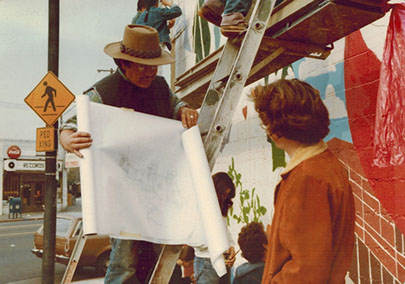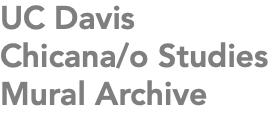Malaquias Montoya began the Mexican and Chicano Mural Workshop at the California College of Arts and Crafts (CCAC) in 1980. Already a prolific muralist in the California Bay Area, Montoya sought to create a curriculum where students could participate in the creation of community art that both challenged and empowered its viewers.  Greatly influenced by Mexican Muralism and Los Tres Grandes (Diego Rivera, José Clemente Orozco, and David Alfaro Siqueiros), Chicano Muralists sought to tell the stories of their community on the walls of their neighborhoods. In this tradition, Montoya’s classes painted murals on schools, community centers, drug prevention centers, food co-ops, and storefronts throughout the East Bay, addressing issues as wide-ranging as education, health, and the numbing effects of mass media, to wars in Central America.
Greatly influenced by Mexican Muralism and Los Tres Grandes (Diego Rivera, José Clemente Orozco, and David Alfaro Siqueiros), Chicano Muralists sought to tell the stories of their community on the walls of their neighborhoods. In this tradition, Montoya’s classes painted murals on schools, community centers, drug prevention centers, food co-ops, and storefronts throughout the East Bay, addressing issues as wide-ranging as education, health, and the numbing effects of mass media, to wars in Central America.
In 1989, Montoya left CCAC for the Chicana/o Studies Department at the University of California, Davis, where the mural workshop, along with the silkscreen poster workshop, became an integral part of the Chicana/o Studies curriculum. Montoya’s classes painted murals throughout Solano and Yolo counties, forming an important bridge between UC Davis and the surrounding region.
In 2010, Malaquias’s son, Maceo Montoya, took over instruction of the Mural Workshop, which he now shares with José Arenas. The class continue to emphasize the importance of community engagement through the arts. Projects in the last decade include murals at Pacific Coast Producers Tomato Cannery, the Yolo County Migrant Head Start, Woodland Community College, Yolo County Juvenile Detention Center, and Prairie Elementary School.
The UC Davis Chicana/o Studies Mural Archive attempts to bring together 40 years of community muralism. Most of the murals no longer exist; many of them are faded and in disrepair. Often painted with house paint, left unvarnished, or in locations chosen without consideration of sun and water exposure, the murals weren’t intended to last forever. They were timely creations, meant primarily for the community members and students who participated in the process. Largely what remains are the images in this archive: over 30 mural drawings and more than 1000 images of the murals themselves, including many of the mural painting in progress. When looking at them as a whole, we see commonalities: images of people breaking free from the barriers and obstacles in their lives; images of people helping one another, pulling each other to safety. Over and over again, we see people turning away from violence, ignorance, and injustice and toward the liberating powers of education, culture, and self-knowledge.
But perhaps what stands out most strongly are the countless images of the workshop participants themselves. Whether on the scaffolding painting, mixing paint, admiring their progress from afar, or posing with the completed mural, the mostly anonymous students in these photographs are taking part in the all too rare experience of creating art collectively, and doing so expressly for communities with otherwise limited access to empowering forms of cultural expression.
This project is indebted to Malaquias Montoya and Lezlie Salkowitz-Montoya, who have generously opened up their personal photo albums and slide collection. For image use or more information regarding the UC Davis Chicana/o Studies Mural Workshop please e-mail Maceo Montoya at mbmontoya@ucdavis.edu.

